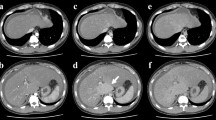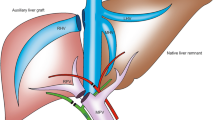Abstract
We report the first case of auxiliary partial orthotopic liver transplantation (APOLT) in a patient with isoniazid (INH)-related fulminant hepatic failure (FHF) with the aim to determine the ability of the native liver (NL) to recover after this particular toxic event. A 10-year-old boy with INH-related FHF underwent APOLT after left hepatectomy on the NL. Neurological status and liver function rapidly improved, but, on postoperative day 22, urgent re-transplantation was needed for graft–hepatic artery thrombosis (HAT) and the NL’s incapacity to sustain adequate liver function. Histological examination of the NL showed signs evident of its regeneration, however. In conclusion, though we faced the clinical failure of the NL functionally to sustain the patient in the presence of the graft HAT 3, weeks after APOLT, such a failure may be interpreted as time related. In fact, the histological picture in this particular case may suggest the potential for NL recovery after INH-related FHF.

Similar content being viewed by others
References
World Health Organisation. Global tuberculosis control: WHO report 2001. World Health Organisation, Geneva. 2001; WHO/CDS/TB/2001.287.
Jasmer RM, Nahid P, Hopewell PC. Latent tuberculosis infection. N Engl J Med 2002; 347:1860.
Vasudeva R, Woods B. Isoniazid-related hepatitis. Dig Dis 1997; 15:357.
Horney JT, Galambos JT. The liver during and after fulminant hepatitis. Gastroenterology 1977; 73:639.
Van Hoek B, De Boer J, Boudjema K, Williams R, Corsmit O, Terpstra OT. Auxiliary versus orthotopic liver transplantation for acute liver failure. J Hepatol 1999; 30:699.
Chernaud-Neu MP, Boudjema K, Bernuau J, et al. Auxiliary liver transplantation: regeneration of the native liver and outcome in 30 patients with fulminant hepatic failure. A multicenter European study. Hepatology 1996; 23:1119.
Boudjema k, Bachellier P, Wolf P, Tempe JD, Jaeck D. Auxiliary liver transplantation and bioartificial bridging procedures in treatment of acute liver failure. World J Surg 2002; 26:264.
D’Antiga L, Dhawan A, Portmann B, et al. Late cellular rejection in paediatric liver transplantation: aetiology and outcome. Transplantation 2002; 73:80.
Meyers BR, Halpern M, Sheiner P, et al. Acute hepatic failure in seven patients after prophylaxis and therapy with antituberculous agents. Successful treatment with orthotopic liver transplantation. Transplantation 1994; 58; 372.
Neuhaus P, Bechstein WO. Split liver/auxiliary liver transplantation for fulminant hepatic failure. Liver Transplant Surg 1997; 5 [Suppl 1]: S55.
Author information
Authors and Affiliations
Corresponding author
About this article
Cite this article
Cillo, U., Bassanello, M., Vitale, A. et al. Isoniazid-related fulminant hepatic failure in a child: assessment of the native liver’s early regeneration after auxiliary partial orthotopic liver transplantation. Transpl Int 17, 713–716 (2005). https://doi.org/10.1007/s00147-004-0798-0
Received:
Revised:
Accepted:
Published:
Issue Date:
DOI: https://doi.org/10.1007/s00147-004-0798-0




